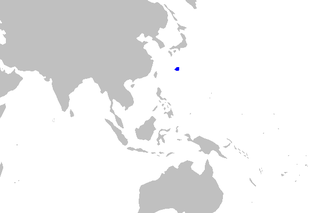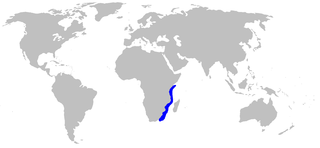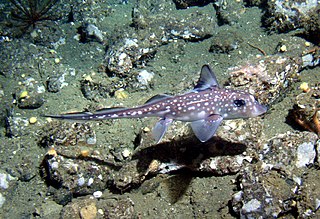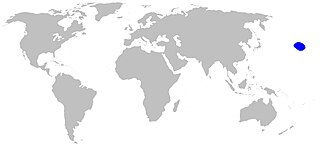
The Squaliformes are an order of sharks that includes about 126 species in seven families.

Apristurus is a genus of catsharks, the family Scyliorhinidae, commonly known as the ghost or demon catsharks.

The blackbelly lanternshark or lucifer shark is a shark of the family Etmopteridae. Found around the world in tropical and temperate seas at depths between 150 and 1,250 meters, E. lucifer can reach up to 47 centimeters in length and consumes mesopelagic cephalopods, fish, and crustaceans. Compared to other mesopelagic fish predators and invertebrates, the blackbelly lanternshark is thought to reside in shallower, more southern waters.

The rasptooth dogfish is a dogfish, found on the Kyushu–Palau Ridge in the northwest Pacific Ocean at depths of 360 m. Its maximum length is unknown. This species was originally described as Centroscyllium sheikoi, and subsequently allocated to the newly named genus Miroscyllium based on anatomical features not shared with other Centroscyllium. More recent molecular data suggest this species belongs to the genus Etmopterus, but as of June 2014 Miroscyllium sheikoi remains the valid name recognized by FishBase, the Catalog of Fishes World Register of Marine Species, and the IUCN

The blurred lanternshark is a little-known species of dogfish shark in the family Etmopteridae, found around the world in benthic and pelagic habitats from a depth of 110 m (360 ft) to over 1 km (0.62 mi) down. This shark forms the E. pusillus species group with the smooth lanternshark, which are distinguished from other members of its family by having irregularly arranged, flat-topped dermal denticles that give them a "smooth" appearance. Both species are slender-bodied with long heads, two dorsal fins bearing spines, no anal fins, and light-emitting photophores. The blurred lanternshark is larger, reaching 67 cm (26 in) or more in length. This species feeds on small squid, fishes, and fish eggs, and is ovoviviparous. It has been assessed as of Least Concern by the International Union for Conservation of Nature, because of its wide distribution and lack of threat from fishing pressure.

The velvet belly lanternshark is a species of dogfish shark in the family Etmopteridae. One of the most common deepwater sharks in the northeastern Atlantic Ocean, the velvet belly is found from Iceland and Norway to Gabon and South Africa at a depth of 20–2,490 m (66–8,169 ft). A small shark generally no more than 45 cm (18 in) long, the velvet belly is so named because its black underside is abruptly distinct from the brown coloration on the rest of its body. The body of this species is fairly stout, with a moderately long snout and tail, and very small gill slits. Like other lanternsharks, the velvet belly is bioluminescent, with light-emitting photophores forming a species-specific pattern over its flanks and abdomen. The ventral photophores are thought to function in counter-illumination, which camouflages the shark against predators and prey. The bioluminescent flank markings may play a role in intraspecific communication.

The Hawaiian Lanternshark is a species of small squaliform shark in the family Etmopteridae.

The smalleye lanternshark is a shark of the family Etmopteridae found in the southeast Pacific off Peru and Chile, at depths between 630 and 1,100 m. Its length is up to 61 cm (24 in).

The African lanternshark is a shark of the family Etmopteridae found in the eastern Atlantic between latitudes 12°N and 18°S, at depths between 300 and 1,000 m. Its length is up to 30 cm.

The thorny lanternshark is a shark of the family Etmopteridae found in the western Indian Ocean between latitudes 0° and 31°S, at depths between 200 and 500 m. Its length is up to 27 cm.

Etmopterus burgessi, sometimes known as the broad-snout lanternshark, is a lanternshark of the family Etmopteridae in the order Squaliformes. It is found only around Taiwan.

Hydrolagus is a genus of fish in the family Chimaeridae found in the Atlantic, Indian and Pacific Oceans.

The shortfin smooth lanternshark is a shark of the family Etmopteridae found off the northeastern coast of Taiwan, at depths of between 430 and 550 m.

The sculpted lanternshark is a shark of the family Etmopteridae found from the Southeast Atlantic and Southwest Indian Ocean, specifically from Namibia to southern Mozambique and the Madagascar Ridge. Etmopterus sculptus is a moderately large species of Etmopterus.

The blue-eye lanternshark, also known as the traveller lanternshark or slate lanternshark is a shark of the family Etmopteridae.

The ninja lanternshark is of the family Etmopteridae, found in the eastern Pacific Ocean from Nicaragua, south to Panama and Costa Rica. The depth range of collections is from 836 to 1443 meters along the continental slope. E. benchleyi is the only Etmopterus species presently known from the Pacific Coast of Central America.

Barrie's lanternshark is a type of lanternshark of the family Etmopteridae, found in Southwest Indian Ocean and Southeast Atlantic Ocean. It lives on seamounts and continental slopes at depths of 480–1,200 m (1,570–3,940 ft). This deep-water shark was previously misidentified with sculpted lanternshark and also resembles blackbelly lanternshark in having linear rows of dermal denticles.

Laila's lanternshark is a species of lanternshark of the family Etmopteridae, found in the northwestern Hawaiian Islands. It inhabits the seamounts at depths of 314–384 m (1,030–1,260 ft). This species resembles Blackbelly lanternshark in having linear rows of dermal denticles.



















